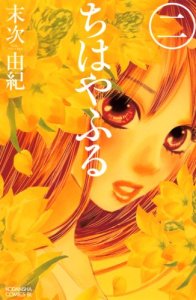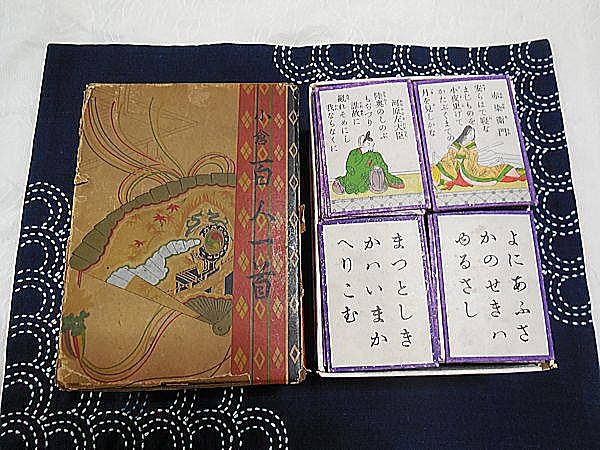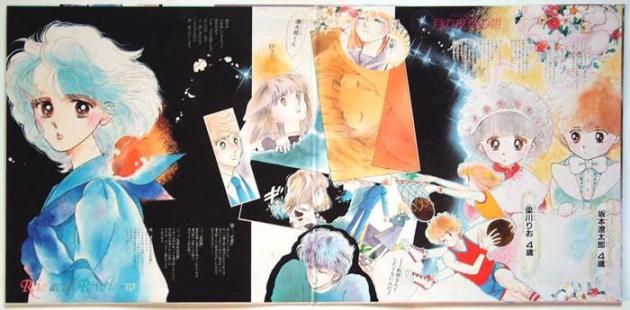Translation: Suetsugu Yuki’s first(?) Chihayafuru Interview
February 6, 2016 12 Comments
“Known for her passionate creation of spaces where manga can be sold, Keibunshō’s Yamakawa Mika is putting her power behind Suetsugu Yuki’s Chihayafuru. “For the first time in a blue moon, my blood is just streaming through my veins! I’m sure there are many readers who think that a title about karuta will be difficult to access, but I believe this is something that will definitely appeal to many of you, regardless of gender.” Overturning the traditional image of karuta, this title keeps attracting more readers with its mix of friendship, romance, tears and fighting spirit! Here, we ask the author about what’s to come!”
This is an interview with Jump Square, published online in November 2008, after Chihayafuru was recommended by Keibunshō’s Yamakawa Mika as a 2008 ‘good read’. At that point, two volumes of the manga tankoubon had been released.
 |
 |
Notes: The original web pages on which this interview was published are no longer available — I found it through archival snapshots of the pages after hearing about it on a discussion forum. If you want to see the Japanese text for any particular section, please leave me a message.
Disclaimer: This translation is entirely my own—please do not copy and paste a substantial part of it elsewhere, though you are welcome to link to it if you wish.
Recently, Keibunshō’s Yamakawa Mika strongly recommended Chihayafuru as a good read. Could you please share with us what sparked your writing a story about such an unusual theme – karuta?
Suetsugu: When I was brainstorming ideas for a serialised story, my editor suggested that I try writing a manga about karuta.
SQ: Was your editor also very experienced?
Suetsugu: You could say that. Once I heard that suggestion, this story just floated into my mind, and I felt that I would definitely be able to do it. So I started looking into the game. And because I’d played karuta briefly in the past, I also felt something of an affinity for it, so it didn’t really feel like I was just conducting research for a manga; I even found it interesting.
SQ: I see. It does indeed feel like you draw this story because you enjoy it.
The emotional content of those match scenes―the tension, the struggle, the players’ fighting spirits and their feelings of joy―did you collect a lot of material that fit into place? Please share with us the circumstances under which you researched it, as well as your experiences. In particular, is there something that left a particularly strong impression?
Suetsugu: The advisor who helps me when I go to research the game cautioned me right at the beginning that I should not move once they start reading the cards. At that moment, I really felt just how serious they all were about karuta. It was just a practice session, but the players were so focused that you could cut the tension in the room with a knife. That atmosphere, that sense of tension, is everything to this game.
 |
SQ: (Wow.)
Suetsugu: I also went to observe a number of high school tournaments. Seeing the students who’d lost on the tatami with tears running down their faces really left a strong impression in my heart. Karuta is one of those competitions that doesn’t draw much attention, but they were so passionate and serious about it. I think that my manga (improved in leaps and bounds) simply because I saw those scenes. The research I’ve done has really made a difference to me.
Henceforth, I imagine that all kinds of friends, rivals, lovers* and teachers will appear before Chihaya. There are also fans who are hoping for episodes associated with the content of certain poems. Is there something in particular that you are keen to depict?
*思い人 literally means ‘person that one thinks about’, and is usually used to refer to that person that has one’s heart. -karice
Suetsugu: The one that I’m most interested in will appear soon―the current Queen whom Chihaya will probably spend the rest of her life alongside, as they dedicate themselves to karuta.
SQ: And with the voices calling for episodes related to the content of poems from the Ogura collection, is there something in particular that you’d like to depict?
Suetsugu: When the balance goes off because it’s been dominated by karuta, I’d like to try depicting what they’d be doing in a school sports or cultural festival. It’d also be fun to see the club split into two for an intra-club match. And I’d also like to include some cultural episodes, in order to weave the content of some of the Ogura 100 poems into the narrative more conscientiously.
SQ: The second volume takes us into their high school days, and I expect we’ll see Chihaya, Arata and Taichi growing and changing as the story progresses. As the author, what do you think will be the thing(s) to look out for?
Suetsugu: Chihaya and Arata are both ‘karuta idiots’, such that they’ll probably continue focusing just on karuta. So I think that the things to look for will be how Taichi changes and the actions he takes. The love triangle between them is rather delicately poised―there’s a sense that once one of them moves, they’ll never be able to go back to how they were before; it’s quite tense for me, depicting this. I’d like to be able to convey the sense of ‘a love that cannot be undone’.
 |
‘A love that cannot be undone’ is also the theme of a number of the Ogura 100 poems, isn’t it? What is your favourite poem? And why?
Suetsugu: “Ogurayama / Mine no momijiba / Kokoro araba / Ima hitotabi no / Miyuki matanan” (#26 => Mostow: O autumn leaves / on the peak of Ogura Hill, / if you have a heart, / I would that you would wait / for one more royal progress.) That notion of calling out to the fall leaves, asking them to wait if they have a heart, is rather romantic. I also like how the sounds bounce off each other.
SQ: The beauty of the card designs also draws your eye; something like the image of tie-dying? Can you give any examples of ideas or (the process) of creating these images?
Suetsugu: I draw the illustrations myself, in my own way, but I leave the card designs to a designer. I like leaving a number of things entirely to the pros.
 |
Have you already got ideas for the ending (of Chihayafuru)?
Suetsugu: I can’t really see what is going to happen in the middle, but I know how I want to end it, and I’m really looking forward to depicting that ending. Because I want to be able to do that properly, and without rushing, I feel pressured to make sure that the path to that finale is exciting and engrossing.
SQ: I’m really looking forward to the highlight scenes, then!
Speaking of drawing, can you tell us about how you set yourself up when you are working, when you draw the ‘name’ and then the panels themselves?
Suetsugu: For the name (storyboard), I can’t concentrate when I’m at home, so I fill my iPod with my favourite songs and go out to a cafe or something similar to draw from 3-10pm or thereabouts. After that’s done, I give that up and just draw at home. As long as I have caramel au laits and chocolate lattes, I can draw for ages. In terms of my workload, currently, I have to draw 60-70 pages a month. For 60 pages, the name takes about one week, the drawings themselves another 5-6 days, and finishings another 2-3 days. But when I’m having trouble with the name, it can take about twice as long. I have two assistants helping me out for 2 nights and 3 days (for the finishings, I assume — karice).
SQ: I’ve also asked this of other mangaka, but what kinds of troubles do you face?
Suetsugu: For example, it’s a pain when the white-out or the ink falls over. Thinking about it now, this is something that’s easily prevented if I just put my mind to it, so I can’t believe I simply haven’t done it yet. I’ll look into it.
SQ: So could you tell us what your daily schedule would be like?
Suetsugu: When I’m working on my drawings, I get out of bed at 11, have yoghurt for breakfast and lunch, ink the drawings all the way through to 7pm, when I have dinner out. Then I return home and continue inking until 4am, when I go to bed. When I’m not working, my waking and sleeping hours are no different.
You’ve been drawing manga earnestly for years now; can you tell us about how you first came to this goal of being a mangaka?
Suetsugu: A friend of mine once lightly told me: “why don’t you become a mangaka?” And that was that, really — I drew manga from my later years in elementary school, started submitting my stories in the first year of junior high, and debuted in my first year of high school. But it didn’t feel real: my thinking even after I debuted was that I would go to university and use that time to gain confidence as a mangaka, and if I succeeded at that, then I’d try to become a pro. Somewhere in my heart, I felt that this was the only profession where I could be the person I was, so I’m glad I became a mangaka.
SQ: You debuted in “Nakayoshi”: is that a magazine that you loved reading?
Suetsugu: That’s right. I grew up reading “Nakayoshi,” and learned about manga from the works of Asagirita-sensei and Hiurasatoru-sensei. I was also deeply impressed by the beautiful art of Honda Keiko, whose work I read in my older sister’s “Ribon” magazines.
 |
SQ: Are there any subjects that you’d like to explore in the future?
Suetsugu: I’d like to write about a sweet maker. I also find the “ensemble cast” format interesting, so I’d like to try that out.
The excitement of competitive karuta, the romance of Japanese poetry, and the beauty of the pictures on the cards…you seem to have captured new readers once again with Chihayafuru. In closing, do you have any messages for your fans and those of Jump SQ?
Suetsugu: Thank you very much for granting me this opportunity to share through an interview. I was really surprised that you were willing to introduce me and my work in a platform aside from my own publisher. I may be the person writing Chihayafuru, but the characters are now their own people, individuals who’ve started to run, getting lost and running into walls as they make their way in the karuta world. I really want to show how they’re giving all they’ve got. I’m also really grateful that even those of you without any connection to karuta are reading this, and I hope that you will stay with me on this journey.
Thank you very much, Suetsugu-sensei!!
Do you have the translation of Suetsugu’s interview from last year?
LikeLike
Not yet…
LikeLike
Pingback: For the record: かるたしよっさ | HOT CHOCOLATE IN A BOWL
“I’d like to be able to convey the sense of ‘a love that cannot be undone’.”
I understand the meaning of the phrase-‘a love that cannot be undone’, but I am having a hard time pulling out instances from the story to justify it. Which scenes from Chihayafuru do you think conveys justifies this phrase appropriately?
LikeLike
I take it to be a reference to Taichi’s love for Chihaya, meaning that it’s not something he can just forget or overcome (e.g. he tried to move on by getting a girlfriend in JHS, but once he was reunited with her, he found that his feelings had not faded or been overwritten at all).
The main reason I think it refers to Taichi is that Suetsugu gave this interview when just two volumes were out, when only Taichi’s feelings were clear, but I also used the original Japanese text to get to this interpretation. The Japanese phrase is 「取り返しのつか ない恋」, which can also be translated as “A love that cannot be taken back” or “An irrevocable love..” Of course, it could also refer to Chihaya’s love for karuta, but I think that unlikely as that wouldn’t make sense given the rest of that particular answer in the interview. Furthermore, the word for “love” is the one for “romantic love,” which I feel would be odd if used to refer to her love for karuta.
LikeLiked by 1 person
Wow this is pretty exciting to learn something new about Suetsugu’s working process. Because of her brilliant work i’ve always been curious to know more about her inner world. Thank you very much for the translation!
But since i’m not a native speaker, some english words are rather vague for my understanding, so could you please provide the japanese for this “love that cannot be undone” thing? Maybe it’ll help me to grasp it better. (Does it mean that one can never fall out of this love or untie this bond? or rather that one cannot undo the fact that he/she once fell in love, therefore it’s impossible to return to the state before this happened?)
LikeLike
You’re welcome. I was actually pretty surprised that so much of this interview was about how she works, but it made it all the more worth translating.
I posted the Japanese phrase above, in reply to the comment above yours: 「取り返しのつか ない恋」. The impression I get from looking at dictionary definitions (DAIJIRIN Japanese-Japanese dictionary) and some Japanese Q&As online is that “koi” (恋) refers specifically to the feelings that one person has for another, regardless of whether they are returned or not. This contrasts with “ren’ai” (恋愛), which can also refer to those feelings but more generally refers to the state of a couple being newly ‘in (romantic) love’.
So, probably a modification of the latter option you gave:
At least, that’s my take on it.
LikeLike
Thank you very much!! I like Your blog and opinions on Chihayafuru you are one of those fews who don’t let thier writings get influenced by shipping or any bias opinion.
Suetsugu said that she already knows the end but because of her last interveiw and what she said about making Taichi such an important character although initially Taichi was set as a supporting character to Arata ; peopole are saying that her her original intended storyline had shifted and she might also change the ending to accommodate that change, is that possible? and what do you think about Arata and chihaya match in the recent chapters?
LikeLiked by 1 person
You’re very welcome. Thank you for dropping by and for your kind comments! I won’t say I’m not biased at all, but I do try to understand where each of the characters is coming from, especially the main trio.
It’s difficult to know just when Suetsugu is referring to as ‘at the start’ in last years’s interview. At the same time, what she and Yoshinaga Fumi talk about suggests that she does indeed mean that his role in the story has grown as she has written it. My personal hunch is that the growth in his role refers mainly to what he decides to do with karuta – i.e. developing his own goals apart from ‘helping Chihaya achieve her karuta dreams’. This will change the ending, but not necessarily in terms of what most of the fandom seems concerned with.
At least, that’s my take on it at this point.
Not sure what to think of the match at the moment, to be honest. It’s certainly come earlier in the story than I originally thought it would…
LikeLiked by 1 person
Wow. I’m also really surprised as Suetgusu-sensei is that Jump SQ would publish an interview with someone from Kodansha.
Very interesting stuff. Thank you for translating it.
LikeLike
Yeah, I thought it was pretty weird. But it’s a pretty good interview, all things considered.
You’re welcome – glad you enjoyed it. ^^
LikeLike
Thanks for this. I just stumbled upon this post from searching online anything related to chihayafuru. It’s nice to read something about the mangaka and about her work.
LikeLiked by 1 person